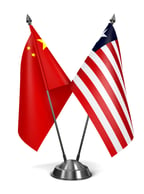Although the beginning of 2020 got off to a promising start for the U.S.-China trade, Covid-19 has completely disrupted the market and is jeopardizing phase 1 of the agreement that the two countries signed in January.
Complicating things further, a diplomatic conflagration has broken out between the countries. The U.S. leveled accusations at Beijing for being responsible for the outbreak of the pandemic and has ordered China to withdraw a number of its U.S.-based employees. China had previously expelled several Wall Street Journal reporters.
China's commitments hanging in the balance
As part of the January agreement, China committed to purchasing $200 billion more in farm goods over the 2017 benchmark year. Clearly, with travel bans, quarantines and supply chain disruptions, China will have difficulty fulfilling its obligations, even without a diplomatic scuffle underway.
As of this writing, there is a glimmer of good news emanating from China relating to fewer confirmed cases of Covid-19. However, the economy suffered and there have been thousands of businesses that either closed or experienced major disruptions for their operations. Estimates for the Chinese economy indicate a projected 9% decline in GDP for Q1 of 2020.
 The ripple effect of business closures created an uncertain timeline for finalizing the terms of the trade agreement. Even for companies that intend to restore U.S. farm purchases are having trouble sustaining their commitment since domestic Chinese demand contracted.
The ripple effect of business closures created an uncertain timeline for finalizing the terms of the trade agreement. Even for companies that intend to restore U.S. farm purchases are having trouble sustaining their commitment since domestic Chinese demand contracted.
Also, Chinese exports contracted by 17.2% for the first two months of 2020 from the prior year. Fortunately, there are provisions that are part of the new agreement that allow for extending the term for fulfilling its covenants. Due to the effects of the pandemic, these provisions are almost certain to be invoked. Recently, China is making some purchases of U.S. farm products, so they are making an attempt to honor the agreement in spite of the challenges.
In addition to farm products, the bill includes provisions relating to seafood, energy, steel, machinery and aircraft products. Undoubtedly, non-farm products will also feel the sting, perhaps more than basic commodities like soybeans and pork products.
Chinese - U.S. trade for the coming years
Even before the virus disruption, the new bill had limited commitments from China. The prospective new purchases only were drawn out through 2021, and the agreement does not include any specific requirements beyond that, only stipulating that there is intent to continue the trajectory of purchases through 2025.
Among farmers and their representatives in government, there is some concern that tethering farm purchases to diplomacy places farmers in a fragile position. On the flip side, China agreed to relax or eliminate a number of health standards that had previously been invoked as a pretext for blocking the importation of certain farm products.  Observers noted there is extensive reciprocity between the countries relating to relaxed import standards for a variety of staple products like milk, chicken and beef.
Observers noted there is extensive reciprocity between the countries relating to relaxed import standards for a variety of staple products like milk, chicken and beef.
The enforcement of the agreement is left to the two parties, and unlike previous agreements, it does not include a provision to revert to a third-party for mediation. In this sense, there is little remedy for enforcement other than to revert to the same policies that induced the trade war in the first instance. Farmers will need to watch the market carefully and hope for controlling the pandemic before it creates systemic and long-term trade disruption.
Stay up-to-date on farm issues at Halderman Real Estate and Farm Management.






